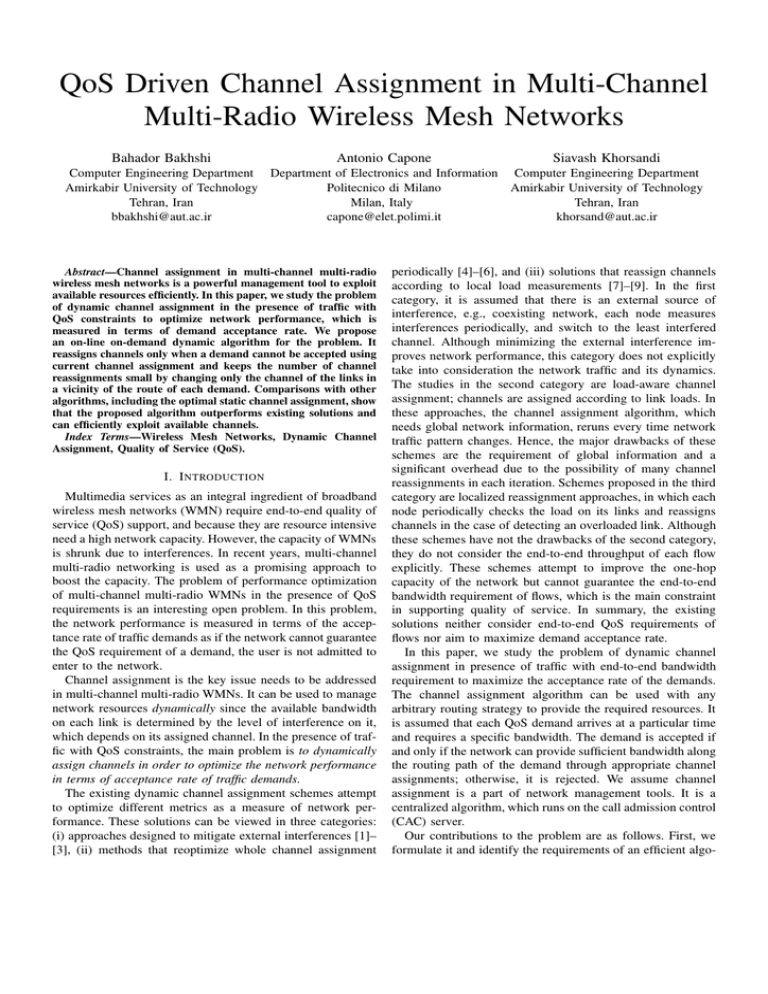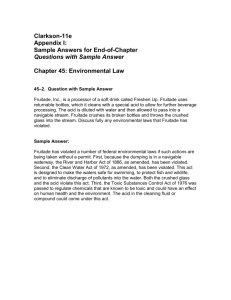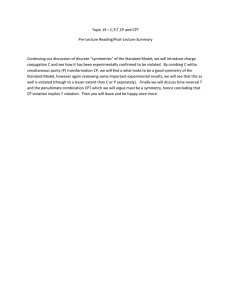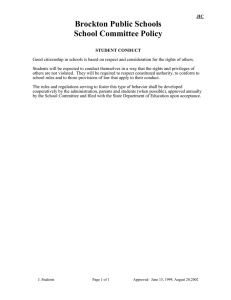QoS Driven Channel Assignment in Multi-Channel Multi
advertisement

QoS Driven Channel Assignment in Multi-Channel
Multi-Radio Wireless Mesh Networks
Bahador Bakhshi
Antonio Capone
Siavash Khorsandi
Computer Engineering Department Department of Electronics and Information Computer Engineering Department
Amirkabir University of Technology
Politecnico di Milano
Amirkabir University of Technology
Tehran, Iran
Milan, Italy
Tehran, Iran
bbakhshi@aut.ac.ir
capone@elet.polimi.it
khorsand@aut.ac.ir
Abstract—Channel assignment in multi-channel multi-radio
wireless mesh networks is a powerful management tool to exploit
available resources efficiently. In this paper, we study the problem
of dynamic channel assignment in the presence of traffic with
QoS constraints to optimize network performance, which is
measured in terms of demand acceptance rate. We propose
an on-line on-demand dynamic algorithm for the problem. It
reassigns channels only when a demand cannot be accepted using
current channel assignment and keeps the number of channel
reassignments small by changing only the channel of the links in
a vicinity of the route of each demand. Comparisons with other
algorithms, including the optimal static channel assignment, show
that the proposed algorithm outperforms existing solutions and
can efficiently exploit available channels.
Index Terms—Wireless Mesh Networks, Dynamic Channel
Assignment, Quality of Service (QoS).
I. I NTRODUCTION
Multimedia services as an integral ingredient of broadband
wireless mesh networks (WMN) require end-to-end quality of
service (QoS) support, and because they are resource intensive
need a high network capacity. However, the capacity of WMNs
is shrunk due to interferences. In recent years, multi-channel
multi-radio networking is used as a promising approach to
boost the capacity. The problem of performance optimization
of multi-channel multi-radio WMNs in the presence of QoS
requirements is an interesting open problem. In this problem,
the network performance is measured in terms of the acceptance rate of traffic demands as if the network cannot guarantee
the QoS requirement of a demand, the user is not admitted to
enter to the network.
Channel assignment is the key issue needs to be addressed
in multi-channel multi-radio WMNs. It can be used to manage
network resources dynamically since the available bandwidth
on each link is determined by the level of interference on it,
which depends on its assigned channel. In the presence of traffic with QoS constraints, the main problem is to dynamically
assign channels in order to optimize the network performance
in terms of acceptance rate of traffic demands.
The existing dynamic channel assignment schemes attempt
to optimize different metrics as a measure of network performance. These solutions can be viewed in three categories:
(i) approaches designed to mitigate external interferences [1]–
[3], (ii) methods that reoptimize whole channel assignment
periodically [4]–[6], and (iii) solutions that reassign channels
according to local load measurements [7]–[9]. In the first
category, it is assumed that there is an external source of
interference, e.g., coexisting network, each node measures
interferences periodically, and switch to the least interfered
channel. Although minimizing the external interference improves network performance, this category does not explicitly
take into consideration the network traffic and its dynamics.
The studies in the second category are load-aware channel
assignment; channels are assigned according to link loads. In
these approaches, the channel assignment algorithm, which
needs global network information, reruns every time network
traffic pattern changes. Hence, the major drawbacks of these
schemes are the requirement of global information and a
significant overhead due to the possibility of many channel
reassignments in each iteration. Schemes proposed in the third
category are localized reassignment approaches, in which each
node periodically checks the load on its links and reassigns
channels in the case of detecting an overloaded link. Although
these schemes have not the drawbacks of the second category,
they do not consider the end-to-end throughput of each flow
explicitly. These schemes attempt to improve the one-hop
capacity of the network but cannot guarantee the end-to-end
bandwidth requirement of flows, which is the main constraint
in supporting quality of service. In summary, the existing
solutions neither consider end-to-end QoS requirements of
flows nor aim to maximize demand acceptance rate.
In this paper, we study the problem of dynamic channel
assignment in presence of traffic with end-to-end bandwidth
requirement to maximize the acceptance rate of the demands.
The channel assignment algorithm can be used with any
arbitrary routing strategy to provide the required resources. It
is assumed that each QoS demand arrives at a particular time
and requires a specific bandwidth. The demand is accepted if
and only if the network can provide sufficient bandwidth along
the routing path of the demand through appropriate channel
assignments; otherwise, it is rejected. We assume channel
assignment is a part of network management tools. It is a
centralized algorithm, which runs on the call admission control
(CAC) server.
Our contributions to the problem are as follows. First, we
formulate it and identify the requirements of an efficient algo-
rithm for it. Second, we design an on-line on-demand channel
assignment algorithm. Finally, we evaluate the algorithm in
terms of demand acceptance rate and study the effect of
various parameters, including demand arrival rate, the number
of available channels, and the number of radios per node.
The remaining of this paper is organized as follows. Assumptions, models, and problem formulation are presented in
Section II. In Section III, we present the QoS Driven Channel
Assignment (QDCA) algorithm and analyze its computational
complexity. Simulation results are presented in Section IV and
Section V concludes this paper.
II. S YSTEM M ODEL AND P ROBLEM F ORMULATION
A. Assumptions
We consider IEEE 802.11 based multi-channel multi-radio
WMNs. In the networks, all nodes are static, node u has
ru radios, and all radios have the same transmission range
TR and the same interference range IR . It is supposed that
the RTS/CTS mechanism is enabled. There are κ orthogonal
channels with the same c Mb/s physical capacity.
B. Network Model
Network is modeled by a digraph G = (V, E), where V is
a set of n vertices and E is a set of m edges. Each v ∈ V
corresponds to a node in the network. Suppose d(u, v) is the
Euclidean distance between u and v. For a given pair of nodes
u and v, there is a link (u, v) ∈ E iff d(u, v) ≤ TR .
C. Interference Model
We use the interference range model [10]. This model, in
conjunction with the RTS/CTS mechanism, yields that links
(u1 , v1 ) and (u2 , v2 ) interfere with each other if a same
channel is assigned to both of them and d(u1 , u2 ) ≤ IR or
d(u1 , v2 ) ≤ IR or d(v1 , u2 ) ≤ IR or d(v1 , v2 ) ≤ IR . The set
of the links interfering with (u, v) is denote by I(u,v) .
D. Available Bandwidth Model
In multi-hop wireless networks, links interfering with each
other have to share the physical channel capacity. To model the
available bandwidth of each link, we use the row constraint
model [11]. Let l(u,v) P
be the load on link (u, v), the row
constraint imposes that (a,b)∈I(u,v) l(a,b) ≤ c. Consequently,
the available
bandwidth of a link is defined as ALB(u, v) =
P
c − (a,b)∈I(u,v) l(a,b) . To satisfy bandwidth requirement of
flows we need ALB(u, v) ≥ 0 for all links in the network.
E. Problem Statement
The problem studied in this paper is to maximize network
performance, which is measured in terms of the acceptance
rate of QoS constrained demands. There is a set of demands
F = {(s, d, b, t, e)}. Demand i arrives at time ti , it requires
bandwidth bi from node si to node di , and if accepted, it leaves
the network at time ei . A demand is accepted if and only if
there is a channel assignment where allocating the required
bandwidth through the path found by a routing algorithm
does not violate capacity constraint of any link. If such path
exists under an appropriate channel assignment, it is named
feasible path. Therefore, the problem is to develop a channel
assignment algorithm that can be used with every routing
algorithm to maintain feasibility of paths found by the routing
algorithm. In this problem, since there is not any information
about a demand before its arrival time, the channel assignment
algorithm must be on-line.
In addition to adapting channels to maximize demand acceptance rate, two further requirements should be met. First,
the number of channel reassignments should be minimized,
which is necessary to reduce the signaling traffic for updating
channels in the network. Second, the solution should use local
information and have a local impact because using the whole
global network information for a channel reassignment leads
to high computational complexity, and if its impact is not
local, the reassignment may propagate in the network, which
is known as the ripple effect problem [7].
III. P ROPOSED S OLUTION
In this section, we first clarify design choices, next, explain
how the choices help us to achieve the design goals, and
finally, present the QDCA algorithm and its computational
complexity analysis.
A. Design Choices
There are four design decisions in the channel assignment
algorithm: channel reassignment strategy, best channel selection metric, group channel change technique, and resource utilization strategy. Our choices for these decisions are clarified
in the following.
1) On-demand Channel Reassignment: Our channel reassignment strategy is on-demand; channels are changed only if
the path found by the routing algorithm is not feasible under
current channel assignment. Infeasibility of path p implies
that allocating bandwidth b through it violates the capacity
constraint of at least one link, ∃(u, v) ∈ E s.t. ALB(u, v) < 0.
The link for which its capacity constraint is violated is referred
as violated link. Note that violated links are not necessarily
in path p, allocating bandwidth b through path p may cause
ALB(u, v) < 0 where (u, v) ∈
/ p.
For a given demand (s, d, b, t, e) and path p, the on-demand
channel reassignment strategy checks feasibility of the path, if
it is not feasible, violated links are found and their channels are
changed to resolve the violations. The best feasible channel is
selected as the new channel for each violated link. Satisfying
feasibility and finding the best channel are explained in the
following.
2) Feasibility Satisfaction: A feasible channel assignment
needs to satisfy capacity and radio constraints. The capacity constraint is defined by the row constraint that needs
ALB(u, v) ≥ 0 ∀(u, v) ∈ E. The radio constraint imposes
that the number of channels assigned to the links of node u
does not exceed ru . Suppose link (u, v) is violated, and we
want to assign a new channel to the link. It is easy to see that
the radio constraint at node u is satisfied if at least one of
the following conditions holds: (i) there is a radio in u that is
already tuned to the new channel, or (ii) there is a free radio,
or (iii) the radio tuned to the old channel can switch to the
new channel; to avoid the ripple effect [7] this condition holds
only if no link except (u, v) uses the old channel. According to
these constraints, we define two types of channels as follows.
Definition 1. Candidate channel for a link is a channel that
satisfies the radio constraint in both nodes of the link.
Definition 2. Valid channel is a candidate channel that also
satisfies the capacity constraint.
3) Best Channel Selection: Resource availability in the
network is the main factor that affects admission of demands.
Selecting a new valid channel for a violated link should
provide resources for the upcoming demands. We define the
resource of the
P network under channel assignment Ψ as
R(G, Ψ) =
(u,v)∈E (ALB(u, v)/|I(u,v) |). Therefore, the
best channel is the one that maximizes R(G, Ψ), where Ψ
is the new channel assignment. If Ψ is obtained from Ψ by
changing the channel of (u, v), it is easy to show that
X
R(G, Ψ) = R(G, Ψ) +
(a,b)∈I(u,v) ∪I (u,v)
−
ALB(a, b)
|I (a,b) |
X
(a,b)∈I(u,v) ∪I (u,v)
ALB(a, b)
, (1)
|I(a,b) |
where, I (u,v) and ALB(u, v) are the interference set and
available bandwidth of (u, v) after channel reassignment. In
(1), the second term is the aggregate resource of the links
in I(u,v) and I (u,v) after changing the channel of (u, v) and
the third term is these resources before the reassignment.
This equation implies that we need to compute the difference
between these two aggregate resources, and the best channel
maximizes the difference. Note that this computation needs
only the information of the links in I(u,v) and I (u,v) , which
are local.
4) Group Channel Change: There are situations in which
there is not any valid channel for a violated link (u, v),
but changing the channel of other links in I(u,v) increases
ALB(u, v), and consequently, can resolve the violation. This
strategy of is called Group Channel Change.
Our recursive procedure is as follows. We distinguish between the in-path violated links and the out-of-path ones.
If violated link (u2 , v2 ) is out-of-path, (u2 , v2 ) ∈
/ p, we
change the channel of links (u3 , v3 ) ∈ I(u2 ,v2 ) one-by-one that
reduces the number of interfering links with (u2 , v2 ) and, as
a result, increases ALB(u2 , v2 ). When violated link (u1 , v1 )
is in-path, for each candidate channel of (u1 , v1 ), we assign
the channel to the link; since it is not a valid channel, this
assignment violates the capacity constraints of some links
(u2 , v2 ) ∈ I(u1 ,v1 ) . Now, we have a new set of violated links
and attempt to resolve them. However, this procedure creates
a loop because if there is not any valid channel for a new
violated link, the group channel change procedure is reapplied
on it, and if it is in-path, the procedure creates another new
set of violated links and so on. To avoid the loop, we treat all
the new violated links as out-of-path links even if they are inpath. Note that this procedure limits channel reassignments in
range 2IR of path p because at most, it changes the channel of
link (u3 , v3 ) if ∃(u2 , v2 ), (u1 , v1 ) such that (u3 , v3 ) ∈ I(u2 ,v2 ) ,
(u2 , v2 ) ∈ I(u1 ,v1 ) , and (u1 , v1 ) ∈ p.
5) On-demand Resource Utilization: Available channels
and radios are scarce resources in multi-channel multi-radio
WMNs. To utilize these resources efficiently, we assign a
channel to each link only if it is in the path of a flow. When a
flow leaves the network, we check all the links in the routing
path of the flow. If there is not any flow routed through link
(u, v) on channel i, we remove the channel from the link and
check radios of nodes u and v; at each node, if no link uses
channel i, we free the radio tuned to the channel. In the initial
channel assignment, when there is not any load, no link has
any assigned channel. In real applications, we need to maintain
network connectivity; thus, to remove the channel of a link, we
temporarily assign a default channel to it. If it is not possible
due to the radio constraint, it implies that some channels are
assigned to the links of the node; hence, the node is already
connected to the network.
B. Achieving Design Goals
The aforementioned design choices fulfill the design requirements mentioned in Section II-E. Acceptance rate is
boosted by the on-demand resource utilization, which frees
channels and radios, group channel change that offers more opportunity to resolve violations, and selecting the best channel
that provides resources for upcoming demands. The number
of channel reassignments is kept small by the on-demand
strategy as it reassigns channels only if needed. The solution is
localized since the best channel is selected according to local
information and the group channel change mechanism limits
channel reassignments in range 2IR of routing paths.
C. QDCA Algorithm
These design choices are integrated in the QDCA algorithm.
Pseudo-code of the algorithm is shown in algorithms 1–3.
In these algorithms, L INK C HANNEL C HANGE(u, v) assigns
the best valid channel to (u, v) if it exists. Note that since
a channel reassignment can resolve violation of multiple
links, after each successful resolve in R ESOLVE V IOLATION,
remaining violated links are rechecked in line 9.
D. Worst Case Computational Complexity
The worst case running time of the QDCA algorithm is the
case that all links in path p are violated and L INK C HAN NEL C HANGE cannot resolve the violations. In this case,
for each link, G ROUP C HANNEL C HANGE is called, wherein
lines 5–9 run and R ESOLVE V IOLATION is called for the
newly generated violated links, N V L. In the worst case,
R ESOLVE V IOLATION calls G ROUP C HANNEL C HANGE for the
new violated links. However, in this case, lines 2–3 run that
breaks the recursive function calls.
Let Iˆ be the size of the largest interference set, r̂ denotes the
maximum number of radios per node, and GCC1 and GCC2 be
Algorithm 1 : QDCA((s, d, b, t, e), p)
1: Check allocating bandwidth b through path p
2: if path p is feasible then
3:
return Accept
4: else
5:
V L ← Violated Links
6:
R ESOLVE V IOLATION(V L)
7:
if violations were resolved then
8:
return Accept
9:
else
10:
return Reject
Algorithm 2 : R ESOLVE V IOLATION(V L)
1: while V L is not empty do
2:
(u, v) ← V L[0]
3:
L INK C HANNEL C HANGE (u, v)
4:
if violation was not resolved then
5:
G ROUP C HANNEL C HANGE (u, v)
6:
if violation was not resolved then
7:
return Reject
8:
else
9:
Remove unviolated links from V L
a random topology, in which 100 nodes were spread in 1000×
1000m2 area, TR = 150m, IR = 350m, c = 100Mb/s, κ =
12, and ru was a uniform random variable in [2, 5]. In each run
of the simulations, a set of 500 random traffic demands was
used, in which the arrival rate was a Poisson random variable,
holding time was an exponential random variable with mean
10 min., and the required bandwidth was a uniform random
variable in [1, 20] Mb/s. We used the minimum-hop algorithm
as the routing algorithm.
In these simulations, QDCA-LCC is the version of QDCA in
which group channel change is not used; QDCA-GCC is the
full version; Random-Static and Greedy-Static are the static
random and greedy minimum interference [12] channel assignment algorithms, respectively. Moreover, we implemented
the dynamic channel assignment algorithm proposed in [9]
that needs an initial channel assignment. Random-Dynamic and
Greedy-Dynamic are two versions of the dynamic algorithm
with the initial channel assignment as the random and greedy
algorithms, respectively.
B. Effect of Demand Arrival Rate
Algorithm 3 : G ROUP C HANNEL C HANGE(u, v)
1: if (u, v) is out-of-path or (u, v) ∈ N V L then
2:
while (u, v) is violated and there is unvisited (a, b) ∈ I(u,v)
do
3:
L INK C HANNEL C HANGE (a,b)
4: else
5:
CC ← Candidate channels for (u, v)
6:
for ∀i ∈ CC and if (u, v) is violated do
7:
Change channel of (u, v) to i
8:
N V L ← New Violated Links
9:
R ESOLVE V IOLATION(N V L)
respectively lines 2–3 and 5–9 of G ROUP C HANNEL C HANGE.
ˆ as we
We have O(L INK C HANNEL C HANGE ) = O(κ(r̂ + I))
need to check the radio and capacity constraints per channel.
ˆ + I)).
ˆ
O(GCC 1 ) = O(L INK C HANNEL C HANGE )Iˆ = O(κI(r̂
ˆ
ˆ
O(GCC 2 ) = O(κr̂ + κ(I + I(O(L INK C HANNEL C HANGE ) +
ˆ as the radio constraint must
O(GCC 1 )))) = O(κ2 Iˆ2 (r̂ + I))
be checked for κ channels to find the candidate channels and
at most there would be Iˆ new violated links that R ESOLVE V I OLATION is called for. The length of path can be at most n, so
O(R ESOLVE V IOLATION ) = n(O(L INK C HANNEL C HANGE ) +
ˆ and finally O(QDCA) =
O(GCC 2 )) = O(nκ2 Iˆ2 (r̂ + I)),
ˆ
ˆ
O(nI) + O(R ESOLVE V IOLATION ) = O(nκ2 Iˆ2 (r̂ + I)).
It should be noted that our simulations, presented in Section
IV-F, show that this worst case occurs very rarely in practice.
IV. S IMULATION R ESULTS
In this section, after describing the simulation setup, we
evaluate the performance of QDCA under various network
loads and configurations.
A. Simulation Setup
We used a flow-level event-driven simulator developed in
Java. All simulations except Section IV-E were performed in
Acceptance rate versus demand arrival rate is shown in
Fig. 1(a). As seen, both versions of QDCA outperform other
static as well as dynamic approaches. Group channel change
improves the acceptance rate of QDCA-GCC up to 10%
in comparison to QDCA-LCC. There are two points about
the approach proposed in [9]: first, its performance depends
on the initial channel assignment—the Greedy-Dynamic has
much better performance than Random-Dynamic. Second,
Greedy-Static outperforms the Greedy-Dynamic especially in
high loads that implies the decisions made by the dynamic
algorithm have negative effects on acceptance of the upcoming
demands.
C. Effect of Number of Available Channels
An efficient channel assignment algorithm should be able
to exploit available channels. Fig. 1(b) shows the performance
of the algorithms versus the number of available channels.
This figure shows that QDCA has the maximum increase of
acceptance rate per additional channel; more precisely, the
average slope of the curves for QDCA based, Greedy based,
and Random based algorithms is, respectively, 0.041, 0.03, and
0.005. The higher slope implies that QDCA has more ability
to exploit additional channels.
D. Effect of Number of Radios per Node
Radios in each node are scarce resources. Efficient algorithms should be capable to provide good performance
even with a limited number of radios. Fig. 1(c) depicts the
performance of the algorithms versus the number of radios.
This figure shows that a limited number of radios per node,
about 4, is sufficient for QDCA-GCC to achieve the maximum
performance. This figure also indicates that the number of radios is an important parameter in the random based algorithms
since providing more radios improves the performance of these
algorithms.
1
0.7
0.7
Acceptance Rate
Acceptance Rate
0.8
TABLE I
C OMPLEXITY AND OVERHEAD OF QDCA
0.8
QDCA−GCC
QDCA−LCC
Greedy−Static
Greedy−Dynamic
Random−Dynamic
Random−Static
0.9
0.6
0.5
0.4
0.6
QDCA−GCC
QDCA−LCC
Greedy−Static
Greedy−Dynamic
Random−Dynamic
Random−Static
0.5
Violations per Demand
Channel Changes per Resolve
0.4
0.3
Arrival Rate (demands per min.)
1
2
3
4
5
3.94 3.95
4.05
4.38
4.88
0.97 0.92
0.87
0.83
0.81
0.3
0.2
0.1
2
4
6
Arrival Rate (Demand / Min)
8
0.2
4
10
(a) Effect of arrival rate
6
8
# of Channels
10
12
(b) Effect of number of available channels
V. C ONCLUSIONS
0.75
1
QDCA−GCC
Optimal
Greedy−Static
0.7
0.9
0.65
Acceptance Rate
Acceptance Rate
0.8
0.7
0.6
0.5
QDCA−GCC
QDCA−LCC
Greedy−Static
Greedy−Dynamic
Random−Dynamic
Random−Static
0.4
0.3
0.2
2
4
6
# of Radios per Node
8
(c) Effect of number of radios
Fig. 1.
0.6
0.55
0.5
0.45
0.4
0.35
10
0.3
2
4
6
Arrival Rate (Demand / Min)
8
(d) Comparison with the optimal static assignment
Simulation results to evaluate QDCA.
The results in Fig. 1(b) and Fig. 1(c) show that providing
many channels with a very few radios per node is sufficient
for QDCA-GCC to achieve good performance. This is also the
situation in the real-life mesh networks, in which there are 12
orthogonal channels in IEEE 802.11a, and each node usually
has 2–4 radios.
E. Comparing with Optimal Static Channel Assignment
To show the superiority of the QDCA algorithm, we compared it against the optimal static channel assignment, which
is obtained by an integer linear programming model proposed
in [12]. Since, the model is not solvable for large networks,
we conducted these simulations in a 25-node network, in
which nodes were spread in 750 × 750m2 area, TR = 200m,
IR = 400m, c = 100Mb/s, κ = 10, and ru was a uniform
random variable in [2, 5]. Fig. 1(d) shows the results in this
topology. As seen, whereas the optimal model has significantly
better performance than Greedy-Static, it is outperformed
by the QDCA-GCC algorithm. These results show that an
efficient dynamic approach can be better than every possible
static algorithm. It must be noted that whereas the difference
between the acceptance rate of QDCA-GCC and the optimal
model is at most 5%, complexity of the optimal model is much
higher than QDCA-GCC; this model is not a practical solution
for real-life large/medium networks.
F. Complexity and Overhead
The average case complexity of QDCA is proportional to the
average number of violations per demand and its overhead to
update channels in the network is influenced by the number of
channel reassignments per resolved violation. These statistics
are reported in Table I. It is seen that the average case
complexity is much less than the worst case as the number
of violations per demand is much less than n. Moreover, the
overhead is not significant as the average number of channel
reassignment per resolved violation is less than one.
10
AND
F UTURE W ORK
We studied the problem of performance optimization of
multi-channel multi-radio WMNs, which is measured in terms
of acceptance rate of QoS constrained traffic demands. We
proposed an on-line dynamic channel assignment solution
which can be used with any arbitrary routing strategy. When
a demand arrives, if the path found for it is not feasible under
current channel assignment, the algorithm detects violated
links. If there is at least one valid channel for each violated
link, it assigns the best one to the link; otherwise, it changes
channels in the interference range of the violated link to
provide additional bandwidth for it. Our simulation results
show that this algorithm, which adapts channel assignment
according to traffic requirements, outperforms even the best
static approach. The proposed solution in this paper is decoupled from routing, we plan to study the joint QoS routing and
dynamic channel assignment problem in the future work.
R EFERENCES
[1] K. N. Ramachandran, E. M. Belding, K. C. Almeroth, and M. M.
Buddhikot, “Interference-Aware Channel Assignment in Multi-Radio
Wireless Mesh Networks,” in IEEE INFOCOM, 2006.
[2] A. Naveed, S. Kanhere, and S. Jha, “Topology Control and Channel
Assignment in Multi-Radio Multi-Channel Wireless Mesh Networks,”
in IEEE MASS, 2007.
[3] J. G. Lim, C. T. Chou, and S. Jha, “Non-Cooperative Coexistence of Colocated Independent Wireless Mesh Networks,” in IEEE MASS, 2007.
[4] A. Raniwala, K. Gopalan, and T. Chiueh, “Centralized channel assignment and routing algorithms for multi-channel wireless mesh networks,”
ACM SIGMOBILE Mobile Computing and Communications Review,
vol. 8, no. 2, pp. 50–65, 2004.
[5] A. H. M. Rad and V. W. Wong, “Joint Optimal Channel Assignment
and Congestion Control for Multi-channel Wireless Mesh Networks,” in
IEEE ICC, 2006.
[6] A. Giannoulis, T. Salonidis, and E. Knightly, “Congestion Control and
Channel Assignment in Multi-Radio Wireless Mesh Networks,” in IEEE
SECON, 2008.
[7] A. Raniwala and T. cker Chiueh, “Architecture and algorithms for an
IEEE 802.11-based multi-channel wireless mesh network,” in IEEE
INFOCOM, 2005.
[8] V. Bhandari and N. H. Vaidya, “Channel and Interface Management in
a Heterogeneous Multi-Channel Multi-Radio Wireless Network,” Dept.
of Electrical and Computer Eng., University of Illinois at UrbanaChampaign, Tech. Rep., March March 2009.
[9] H. Wu, F. Yang, K. Tan, J. Chen, Q. Zhang, and Z. Zhang, “Distributed
Channel Assignment and Routing in Multiradio Multichannel Multihop
Wireless Networks,” IEEE Journal on Selected Areas in Communications, vol. 24, no. 11, pp. 1972–1983, nov. 2006.
[10] A. Iyer, C. Rosenberg, and A. Karnik, “What is the Right Model
for Wireless Channel Interference?” IEEE Transactions on Wireless
Communications, vol. 8, no. 5, pp. 2662–2671, 2009.
[11] R. Gupta, J. Musacchio, and J. Walrand, “Sufficient rate constraints for
QoS flows in ad-hoc networks,” Elsevier Ad Hoc Networks, vol. 5, no. 4,
pp. 429–443, 2007.
[12] A. Subramanian, H. Gupta, S. Das, and J. Cao, “Minimum Interference
Channel Assignment in Multiradio Wireless Mesh Networks,” IEEE
Transactions on Mobile Computing, vol. 7, no. 12, pp. 1459–1473, dec.
2008.



